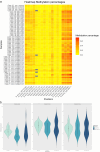CDH1 methylation analysis in invasive lobular breast carcinomas with and without gene mutation
- PMID: 38713384
- PMCID: PMC11329400
- DOI: 10.1007/s00428-024-03814-8
CDH1 methylation analysis in invasive lobular breast carcinomas with and without gene mutation
Abstract
The proposed role of CDH1 (E-cadherin gene) methylation as a mechanism of gene inactivation in invasive lobular carcinoma (ILC) remains inconclusive. For many years, CDH1 promoter hypermethylation has been regarded as a mechanism for gene inactivation in ILC. However, this assumption has primarily relied on non-quantitative assays, which have reported CDH1 methylation frequencies ranging from 26 to 93% at CpG sites within the island region. Few studies employing quantitative methods and covering CpG island shores, regions of relatively low CpG density situated proximal to conventional promoter CpGs, have been conducted, revealing lower percentages of methylation ranging from 0 to 51%. Therefore, using the quantitative pyrosequencing method, we examined CDH1 methylation in the island region and shores in E-cadherin deficient ILC cases (15 with CDH1 mutation and 22 non-mutated), 19 cases of invasive breast carcinomas non-special type (IBC-NSTs), and five cases of usual ductal hyperplasia (UDH). Our analysis revealed CDH1 methylation frequencies ranging from 3 to 64%, with no significant increase in methylation levels in any group of ILCs (median = 12%) compared to IBC-NST (median = 15%). In addition, considering the poorly studied association between the number of tumor-infiltrating lymphocytes (TILs) and CDH1 methylation in breast cancer, we undertook a thorough analysis within our dataset. Our findings revealed a positive correlation between CDH1 methylation and the presence of TILs (r = 0.5; p-value < 0.05), shedding light on an aspect of breast cancer biology warranting further investigation. These findings challenge CDH1 methylation as a CDH1 inactivation mechanism in ILC and highlight TILs as a potential confounding factor in gene methylation.
Keywords: CDH1; Breast cancer; DNA methylation; Lobular carcinomas.
© 2024. The Author(s).
Conflict of interest statement
Consulting/advisor: Roche, AstraZeneca, Seattle Genetics, Daiichi Sankyo, Lilly, Merck Sharp&Dohme, Leuko, Bioasis, Clovis Oncology, Boehringer Ingelheim, Ellipses, Hibercell, BioInvent, Gemoab, Gilead, Menarini, Zymeworks, Reveal Genomics, Scorpion Therapeutics, Expres2ion Biotechnologies, Jazz Pharmatheuticals, Abbvie. Honoraria: Roche , Novartis , Eisai, Pfizer, Lilly, Merck Sharp&Dohme, Daiichi Sankyo, Astrazeneca, Gilead, Steamline Therapeutics. Research funding to the Institution: Roche, Ariad pharmaceuticals, AstraZeneca, Baxalta GMBH/Servier Affaires, Bayer healthcare, Eisai, F.Hoffman-La Roche, Guardanth health, Merck Sharp&Dohme, Pfizer, Piqur Therapeutics, Queen Mary University of London, IQVIA. Stock: MAJ3 Capital, Leuko (relative). Travel, accommodation, expenses: Roche, Novartis, Eisai, Pfizer, Daiichi Sankyo, Astrazeneca, Gilead, Merck Sharp&Dohme, Steamline. Patents:
Figures


Similar articles
-
CDH1 promoter hypermethylation and E-cadherin protein expression in infiltrating breast cancer.BMC Cancer. 2006 Mar 2;6:48. doi: 10.1186/1471-2407-6-48. BMC Cancer. 2006. PMID: 16512896 Free PMC article.
-
Epigenetic silencing in non-neoplastic epithelia identifies E-cadherin (CDH1) as a target for chemoprevention of lobular neoplasia.J Pathol. 2009 Jun;218(2):265-72. doi: 10.1002/path.2541. J Pathol. 2009. PMID: 19294736
-
Epigenetic and genetic alterations of APC and CDH1 genes in lobular breast cancer: relationships with abnormal E-cadherin and catenin expression and microsatellite instability.Int J Cancer. 2003 Aug 20;106(2):208-15. doi: 10.1002/ijc.11197. Int J Cancer. 2003. PMID: 12800196
-
Malignant phyllodes tumor and invasive lobular breast carcinoma: Morpho-molecular characterization of an uncommon collision tumor and review of the literature.Pathol Res Pract. 2024 Feb;254:155100. doi: 10.1016/j.prp.2024.155100. Epub 2024 Jan 18. Pathol Res Pract. 2024. PMID: 38277744 Review.
-
[Practical problems in breast screening. Columnar cell lesions including flat epithelial atypia and lobular neoplasia].Pathologe. 2008 Nov;29 Suppl 2:172-7. doi: 10.1007/s00292-008-1037-8. Pathologe. 2008. PMID: 18726595 Review. German.
Cited by
-
Unique Molecular Alteration of Lobular Breast Cancer: Association with Pathological Classification, Tumor Biology and Behavior, and Clinical Management.Cancers (Basel). 2025 Jan 27;17(3):417. doi: 10.3390/cancers17030417. Cancers (Basel). 2025. PMID: 39941785 Free PMC article. Review.
-
The Role of the CDH1 Gene in the Pathogenesis and Progression of Lobular Breast Cancer.Cureus. 2025 Aug 3;17(8):e89290. doi: 10.7759/cureus.89290. eCollection 2025 Aug. Cureus. 2025. PMID: 40757085 Free PMC article. Review.
References
-
- WHO Classification of Tumours Editorial Board, International Agency for Research on Cancer, World Health Organization (2019) WHO classification of tumours. Breast Tumours. International Agency for Research on Cancer, Lyon
-
- Sarrió D, Moreno-Bueno G, Hardisson D et al (2003) Epigenetic and genetic alterations of APC and CDH1 genes in lobular breast cancer: relationships with abnormal E-cadherin and catenin expression and microsatellite instability: E-Cadherin, Catenins and APC. Int J Cancer 106:208–215. 10.1002/ijc.11197 10.1002/ijc.11197 - DOI - PubMed
MeSH terms
Substances
LinkOut - more resources
Full Text Sources
Medical
Miscellaneous

